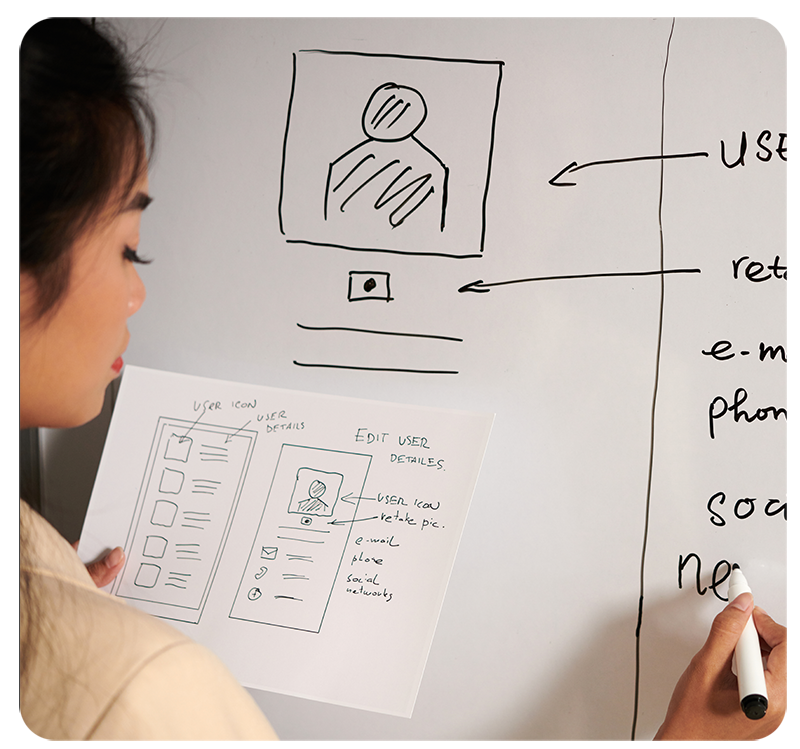Our Research Shows
Elective users are less likely to return to a site after a bad user experience.
Consumers generally are willing to pay more for a better customer experience.
Good UX Design raises conversions in a short period of time by as much as 400%.
What is UX Design?
User experience (UX) design is the process of improving the user experience on your website or app. The goal is to enhance user satisfaction by improving the accessibility, usability, and efficiency of user interactions on your website. Several factors impact the UX, from core graphics and navigation to page layout, form length to calls to action.
Importantly, the better your user experience, the better a search engine will rank your website too, which means more traffic. A common aspect of UX best practices is streamlining the content you present to site visitors, so they don’t get distracted or confused as they try to achieve their goal. For instance, if you make the checkout process more streamlined with simpler forms, clear calls to action and easy payment, visitors will be more likely to buy your products. They don’t have to jump over hurdles, so this seamless experience helps to increase customer satisfaction and retention.


Why does UX Design matter?
User experience design is critical because customers expect it. No matter what you sell, or what industry your business is in, customers expect their online experience to be smooth, intuitive, and personalized. Fail to deliver on your customers’ expectations and you will lose them to those brands who are.
No one is going to stick around for a bad website experience. Simple as that. On the positive side, companies that invest in UX see a lower cost of customer acquisition, lower support costs, increased customer retention and increased market share.
Knowing your users and designing your website experience for them is the key to unlocking a better ROI. User Experience optimization is the art and science of maximizing the experience a user has with a website. Good UX means you can provide users with a great brand experience while they navigate your website. This has a long-term impact too: By offering a frictionless user experience, some businesses have achieved a mammoth ROI of up to 9,900%. So how do you achieve the user experience your customers want?




How we optimize the UX Design process
The most important part of the UX design process is to understand and empathize with your users. Even if you think you understand them now, you need to go deeper. How do they act and think? What do they want from your website? How do they navigate your site? All the steps below will reveal more about your users, so you can make the changes to create the website user experience they want.
Our four essential steps to build an optimal user experience:
1. Identify Core Tasks
What are the steps users need to take to achieve their goals on your website? These are your user’s core tasks. We start by taking a step back and working out what their goals are. Importantly, these user goals should relate to the real world – not just the site.
For example, user goals could be to learn how to build a deck, buy a house or plan the perfect wedding. Then, we figure out the steps for users to take to reach their goals. We map it out from the moment they arrive at your landing page or home page, through to the point where they achieve their goal while making the journey as smooth as possible.
How do we find out what the core tasks are?

We look at behavioral data to learn what your website users do now.

We form a hypothesis about why this is the case.

We then test the hypothesis.
2. Analyze Behavioral Data
Behavioral data analysis is a key component of UX Design. Think of this as the “What is happening” data. Sometimes this can be as simple as looking at the quantitative data you already have in web analytics.
Some of the things our team looks for:

Session duration – how long users are on your website, which helps you understand the engagement of visitors,

Bounce rate – percentage of traffic who land on a page and leave without action,

How long it takes for them to achieve their goal, i.e. convert,

SEO keyword data – which search terms are attracting visitors to your website through SEO and are these visitors converting?
3. Testing Phase
Testing is a critical step in the user experience design process. 85% of issues related to UX design can be detected by performing usability testing. Testing takes the guesswork out of UX design. It ensures every decision made about the call to action, button size, images, white space on pages, and so on, are all based on data-driven insights.
Questions we answer:
- What drives a user to open the emails in their inbox or push notifications they receive?
- Where do visitors drop off?
- Which features are most used?
There are many ways we test:

A/B tests and multivariate tests

Control groups

Random sampling
4. Implement and Iterate
We implement the results of testing into your website. We take the insights gathered from behavioral data and testing and use it to make improvements to the site and see conversion rates rise.
This might mean changing the color of the call to action, changing the navigation, using more educational content, adding video content to pages, speeding up page load times, refining keywords for search engines, and much more.



